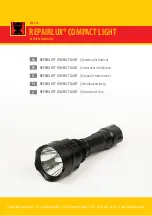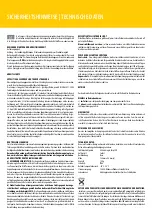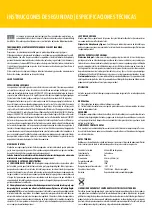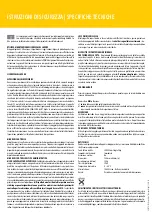
sAFETY InsTRUCTIOns | TECHnICAL sPECIFICATIOns
The lamp is designed for the following application purpose: curing materials with
visible light. The lamp is manufactured exclusively for Heinrich König GmbH & Co. KG
and may only be used to cure light-curing filling materials
OPERATING, MAINTENANCE AND HEALTH AND SAfETY MANUAL
Risk Group 2
Caution - possibly hazardous optical radiation emitted from this product
Operation and maintenance should only be performed by suitably qualified and trained personnel.
In order to help prevent accidents or ill health all operators and maintenance personnel must read
carefully, fully understand and follow all the instructions and warnings contained in this manual
BEfORE
operation or maintenance for the first time.
This manual should always be readily available to all operators and maintenance personnel. It
should be prominently located in the area of usage.
HEALTH AND SAfETY
-
VISIBLE LIGHT ExPOSURE
Over exposure to visible light can cause adverse health effects, such as skin burns and retinal damage
to the eye. This torch is classified Risk Group 2 – moderate risk, in accordance with BS EN 62471 : 2008
Photobiological Safety of Lamps and Lamp Systems. This means that this torch will not pose either
a retinal blue-light hazard or a retinal thermal hazard within 0.25 seconds, which is the aversion
response. The risk of adverse health effects is reduced with distance, for example, the distance at
which this torch would be regarded as Risk Group 1 is 1.23 metres and the distance at which it would
be regarded as exempt is 9.3 metres. Occupational visible light exposure is subject to the Control of
Artificial Optical Radiation at Work Regulations 2010, which brought into law on 27th April 2010 ,
the European Physical Agents (Artificial Optical Radiation 2006/25/EC) Directive (AORD 2006/25/
EC). This incorporates statutory exposure limit values (ELVL’s) which are based on those defined by
the International Commission on Non Ionising Radiation Protection (ICNIRP). In cases of persons
subjected to visible light emissions from artificial sources, it is necessary to assess the level of risk
for adverse health effects by determining personal light exposure levels and comparing with the
exposure limit values. Where personal exposure levels comply with the exposure limit values, the
risk can be considered low for the majority of the population and adequately controlled so far as is
reasonably practicable. Where personal exposure exceeds the exposure limit values, then additional
control measures must be implemented which decrease exposure to below the exposure limit values.
CONTROL MEASURES
The objective is to ensure that the visible light exposure limit values for the unprotected skin and
eye are not exceeded by any person. This can be achieved by a combination of the following control
methods: administrative and personal protective equipment.
Emphasis should be placed on administrative control measures to minimise the need
for personal protective equipment.
ADMINISTRATIVE CONTROL MEASURES
a) HAZARD AWARENESS:
The operator should always point the visible light beam away from
their body and never shine directly at anyone’s unprotected skin or eyes.
All persons who could be exposed to levels of visible light exceeding the exposure limit values or signif-
icant personal exposure must be provided with sufficient information, instruction and training to un-
derstand the associated risks to their health and the precautions which should be taken to adequately
manage the risk. Any person who notices any unusual or adverse reaction thought to be due to visible
light exposure should not be further exposed until after consulting with a suitably qualified person.
b) Compliance with the visible light exposure limit values for the unprotected skin and
eye in accordance with the Control of Artificial Optical Radiation at Work Regulations
2010.
The visible light exposure limit values are set below threshold levels of light exposure where
observable adverse health effects would occur and incorporate significant safety margins.
If the maximum permissible exposure values are exceeded then the visible light irradiance must
be reduced by appropriate control measures. These could include moving further away from the
source, reducing exposure time, containment, or as a last resort provision of personal protective
equipment (PPE).
REfLECTED VISIBLE LIGHT
Many surfaces, especially those that are smooth and/or highly reflective and/or light coloured,
are often good reflectors of light.
Warning labels and signs
– Should be used to indicate the presence of visible light which
could result in persons being exposed to levels exceeding the exposure limit values, or significant
personal exposure.
PERSONAL PROTECTIVE EqUIPMENT
Protection of the skin
– The most effective way to protect the skin from visible light is to cover it.
The areas of skin usually at risk are the backs of the hands, forearms, face and neck, as other areas
are usually covered by clothing. The hands can be protected by wearing gloves and arms can be
covered by long sleeves, using material with low light transmission. In general, darker coloured,
heavier fabrics with a closed structure offer a higher level of protection than light coloured, light
weight fabrics with an open structure. The face can be protected by a 455 nm blocking face shield
and this will also provide eye protection.
Protection of the eyes
– We recommend that where personal visible light exposure could be
significant, all persons affected should always wear 455 nm blocking spectacles will ensure pro-
tection against any residual risk.
OPERATION
Before switching on, always check the following. If in any doubt whatsoever do not switch on.
NEVER OPERATE:
a) If there is any visible damage to the torch or batteries.
b) Without the necessary control measures in place for protection against exceeding the visible
light exposure limit values.
SWITCHING ON
The operator should always point the visible light beam away from their body and never shine
directly at anyone’s unprotected skin or eyes. Switch on and off using the power switch on the
rear of the torch. Once switched on it will reach it’s optimum visible light output almost instantly.
CLEANING Of fRONT GLASS
To ensure optimum performance keep the front glass clean. Wipe over the surface of the front glass
with a soft, damp, lint free cloth or Alcowipe. Never use any soaps, detergents or abrasive materials.
TECHNICAL DATA
Due to our policy of continuous development, we reserve the right to amend technical data and
therefore information may be subject to change without prior notice.
Visible light source:
455nm Single Chip LED
Warm up:
Instant
Hot restrike:
No
Dimensions:
145 mm x 44 mm (ø)
Weight including battery:
150g
Rating: IP64
Operating ambient temperature range:
-20°C - 35°C
Power supply:
18650 rechargeable Li-ion Battery
Running time:
Depends on the number of on/off switching cycles .
DISPOSAL Of ELECTRICAL AND ELECTRONIC APPLIANCES AND COMPONENTS
For the sake of our environment and in order to recycle as completely as possible the raw materials
used, the end-user is requested to deliver used or defective appliances to a public waste collection
point for electronic scrap. A crossed-out wheeled bin symbol indicates that the product is to be
delivered to a collection point for electronic scrap to ensure that raw materials are recycled in the
best possible way. Thus, you fulfil your legal duties and contribute to environmental protection!
EN


























